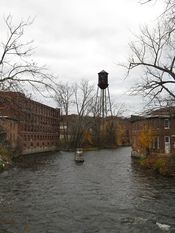- Miskatonic River
-
Contents
The Miskatonic River is a fictional New England river in the writings of H. P. Lovecraft. It is also the name of a river system, the Miskatonic Valley. The equally fictitious Miskatonic University in Arkham is named after this river. The Miskatonic was first mentioned (as "Miskatonic Valley") in Lovecraft's "The Picture in the House" (1920).
The fictional communities of Arkham and Dunwich, Massachusetts are said to be located along the Miskatonic. In "The Colour Out of Space" (1927), the narrator claims that there is a "small island in the Miskatonic where the devil held court beside a curious stone altar older than the Indians."
Location
The Miskatonic seems to follow a west-to-east path across Massachusetts, originating from springs in the hills west of Dunwich. It runs eastward past Dunwich, turns southeast, and flows through Arkham. The river empties into the sea two miles to the south near Kingsport, which lies just to the northeast.
Origin
Lovecraft concocted the word Miskatonic from a mixture of root words from the Algonquian language[1]. Place-names based on the Algonquian languages, which was nearly extinct by the 17th century, are still found throughout New England. Anthony Pearsall believes that Lovecraft based the name on the Housatonic River[2] which extends from the Long Island Sound through the Berkshires of Western Massachusetts and western Connecticut.
Daniel Harms suggests that Miskatonic is derived from the Misqat, a tribe descended from the Native Americans of Massachusetts.[3]
Another likely origin, to the mind of this editor, for the word Miskatonic is that it actually is a phonetic contraction of the English prefix 'Mis-', indicating something wrong (as in ‘misplaced’), or bad (as in ‘misanthropy’), and Chthonic (from Greek χθόνιος – chthonios, "in, under, or beneath the earth"), which designates, or pertains to, deities or spirits of the underworld, especially in relation to Greek religion. The Greek word khthon is one of several for "earth"; it typically refers to the interior of the soil, rather than the living surface of the land. It evokes at once abundance and the grave.[4] This would clearly fit with Lovecraft’s wit and mythos.
See also
References
- Harms, Daniel (1998). "Miskatonic River". The Encyclopedia Cthulhiana (2nd ed. ed.). Oakland, CA: Chaosium. p. 194. ISBN 1-56882-119-0.
- Lovecraft, Howard P. (1998). Selected Letters III. Sauk City, WI: Arkham House. ISBN 0-87054-032-7.
- Pearsall, Anthony B. (2005). The Lovecraft Lexicon (1st ed. ed.). Tempe, AZ: New Falcon Pub. ISBN 1-56184-129-3.
Notes
- ^ Lovecraft, Selected Letters III, p. 432.
- ^ Pearsall, "Miskatonic River (Valley)", The Lovecraft Lexicon, p. 281.
- ^ Harms, "Miskatonic River", The Cthulhiana Encyclopedia, p. 194.
- ^ Origin of the word ‘Chthonic’, .
Further reading
- Murray, Will (January 1999) [1987]. "Roots of the Miskatonic". In James Van Hise (ed.). The Fantastic Worlds of H. P. Lovecraft (1st ed. ed.). Yucca Valley, CA: James Van Hise. pp. 94–6.

This fictional location article is a stub. You can help Wikipedia by expanding it.

